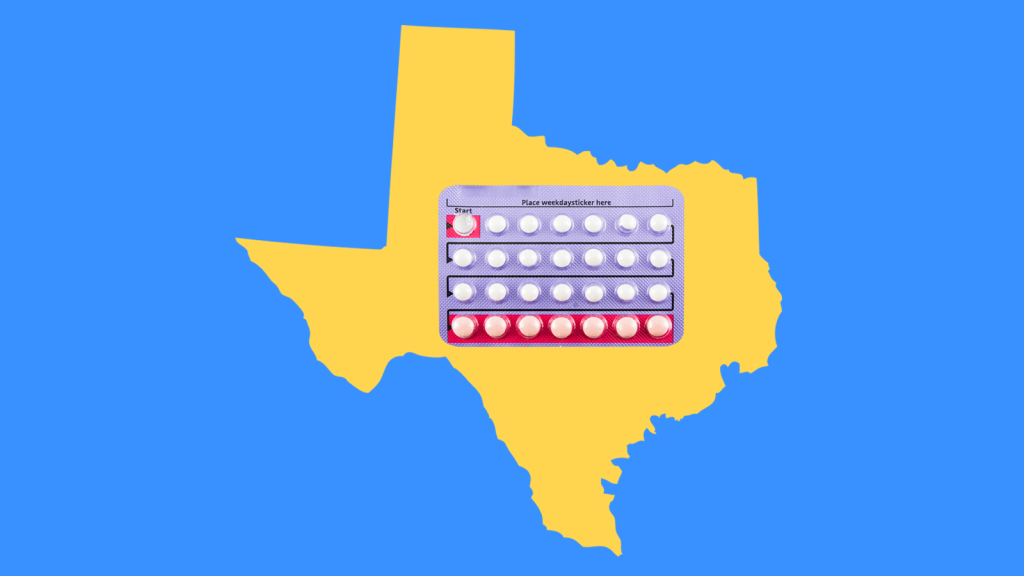By Sarah Lopez
Image from Grist
Texas offers a few different options to help people prevent pregnancy. For those with insurance, birth control is required to be covered thanks to the Affordable Care Act. For those without insurance, some state programs and federally-funded clinics can help you get birth control for free or at a very low cost.
You may qualify for CHIP, Healthy Texas Women, Medicaid, or you can go to a Title X clinic or use an app called Nurx. You can also pay out of pocket at a CVS Minute Clinic. Title X clinics function on such a sliding scale, which means that you won’t have to pay more than you can afford based on your income. For most teens or those without income, services including birth control & STD testing will be free. Other programs require copays or enrollment fees, or charge differently depending on your insurance. Your first appointment may include your medical history, a pelvic exam, and a discussion with your provider about the different birth control options. This is a breakdown of the different programs that can help pay for birth control in Texas:
| Funding Source
/Program |
Copay | Eligibility | Is parental consent required to enroll? | Is parental consent required for birth control? | Is birth control covered? |
| CHIP | There is an enrollment fee of $50 or less and if a copay is required, it will not exceed $35. | -Ages 18 and under
-Must be a resident of Texas & U.S. citizen or a legal permanent resident -If family income is too high for Medicaid |
Yes | N/A | No, only for medical needs besides pregnancy prevention. |
| STAR Texas Medicaid | No copays required. | -Anyone 18 and under
-Must be a resident of Texas & U.S. citizen or legal permanent resident |
Teens can apply on their own if they live on their own or are pregnant; otherwise an adult who lives with them half the time or more must apply on their behalf | No | Yes |
| Healthy Texas Women | If copay is required, it will not exceed $30. | -Women ages 15-44 years old
-If you don’t have insurance -Must be a resident of Texas & U.S. citizen or a legal immigrant |
Yes; for women ages 15-17 a parent or legal guardian must apply, renew, and report changes to your case on your behalf | Yes | Yes, as is emergency contraception. |
| Title X | Depending on your income, you may get a discounted fee or not have one at all. | -People of any age
-With or without insurance –regardless of documentation status |
No enrollment necessary | No | Yes, as is emergency contraception. |
| Nurx | -With most insurance plans: free
-Without insurance: $15 |
-Must be at least 18 years of age | No, you may only enroll if you are over 18. | N/A | Yes, as is emergency contraception. |
| CVS Minute Clinics | -With most insurance plans: free
-Without insurance: $59-69, plus cost of birth control |
-Must be at least 18 years of age or have parental consent | N/A | Yes | Yes, as is emergency contraception. |
Having trouble viewing this table or want to print? Download as a PDF.
The process may seem daunting, but it’s far better than worrying about whether or not you’ve been careful enough without birth control. From longest-lasting to shortest-lasting, here are a few different options for the kinds of birth control you can get to prevent pregnancy. All are used & controlled by the person who can get pregnant, except for the male condom. The male condom is also the only method that also protects against STIs, including HIV. It’s important to talk to your partner about how you’ll prevent STIs and pregnancy, even though it can be scary!
- Long-Acting Reversible Contraception
- Copper T intrauterine device (IUD) – A small, “T” shaped device placed inside the uterus that can stay in place for up to 10 years (0.8% failure rate with typical use)
- Hormonal IUD – Levonorgestrel intrauterine device (LNG IUD) – Also a small “T” shaped device placed on the uterus that releases a small dose of progestin each day and can stay in place for up to five years (0.2% failure rate with typical use)
- Implant – A small, thin rod placed on a woman’s upper arm and releases progestin into the body over the course of three years (0.05% failure rate with typical use)
- Hormonal Methods
- “The Pill” – Oral contraceptive that contains estrogen and progestin that is prescribed by a doctor and taken at the same time each day (9% failure rate with typical use)
- “The Mini Pill” – Unlike “The Pill,” this method contains progestin only; best for women who cannot take estrogen (9% failure rate with typical use)
- Injection – A shot given by a doctor on a woman’s arm or buttocks every 3 months (6% failure rate with typical use)
- Patch – Worn on the lower abdomen, buttocks, or upper body (though not breast area), the patch is prescribed by a doctor and releases estrogen and progestin. It must be changed once a week for three weeks and on the fourth week must be taken off to allow time for a menstrual period (9% failure rate with typical use)
- Ring – Placed inside the vagina like a tampon, the ring releases estrogen and progestin for three weeks, at which point it must be taken out to allow time for a menstrual period. After this time, a new ring must be inserted (9% failure rate with typical use)
- Barrier Methods
- Diaphragm- A thimble-sized, cup shaped device that must be inserted vaginally with spermicide before sex. (12% failure rate)
- Male Condom – Worn by the man and meant for one-time use only; keeps sperm from getting into a woman’s body (18% failure rate with typical use)
- Female Condom – Looks just like a male condom but with a ring in the end that closes, it can be purchased at a drug store and inserted vaginally up to eight hours before having sex (21% failure rate with typical use)
The news has talked a lot lately about how the current state & federal administrations want to cut access to birth control. While it may feel as though anti-choice rhetoric looms both at the federal and state levels, all hope is not lost. Despite the fact that Gov. Greg Abbott is comfortable asking President Trump for millions of dollars that were lost after banning Planned Parenthood, Title X clinics are still able to carry out their mission in providing access to birth control regardless of financial or insurance status.
According to a study by the Guttmacher Institute, publicly supported health centers provided contraceptive care to 184,540 women in Texas in 2014, including 107,540 women served by Title X–supported centers. Health centers in Texas served 31,030 teenage women in 2014, including 18,170 teens served by Title X–supported centers. As encouraging as this data may be, we still have a long way to go until affordable birth control is common practice.
If you’re a young person and you have questions or need help finding a Title X clinic near you, text or call our hotline at 866-999-5263!




